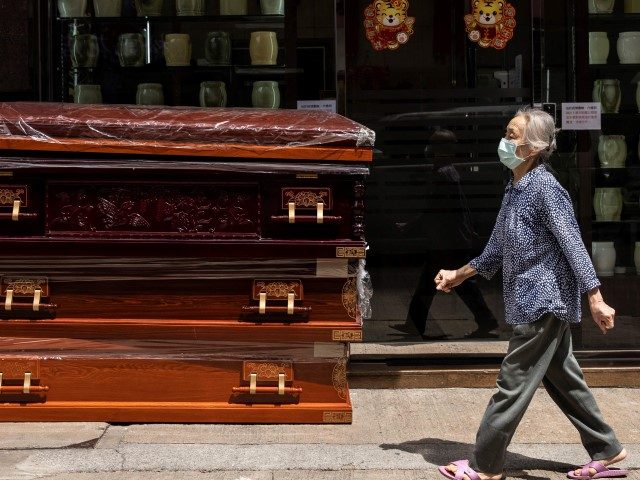The World Health Organization (W.H.O.) group tasked with tracking Chinese coronavirus variants suggested Wednesday that state actors should “conduct independent and comparative analyses” in addition to using data coming out of China regarding the ongoing catastrophic spread of the disease in that country.
The same day, W.H.O. officials said at a press conference that they believe the Chinese government is undercounting the number of coronavirus deaths occurring in the country since its decision to no longer impose city-wide lockdowns and to limit the imprisonment of potential patients in unsanitary quarantine camps. China “optimized” its coronavirus response by vowing more limited use of mass house arrests and quarantine imprisonments in early December, following a nationwide wave of protests and riots.
China is facing what many outside observers believe could be the most severe outbreak of the disease in the country since it originated there in late 2019. Independent reporting, heavily censored by Communist Party authorities, indicates Chinese morgues, funeral homes, and hospitals are struggling to keep up with the surge in deaths following the government’s announcement in December that it would no longer force city-wide lockdowns on its citizens and imprison them in quarantine camps. The reporting, including video footage of long lines at crematories, is at odds with the official government statistics on the number of deaths attributable to the disease.
The BMJ, formerly the British Medical Journal, accused China in an article published Tuesday of simply ceasing to count any deaths attributable to Chinese coronavirus infections at all.
“The Chinese National Health Commission’s official daily briefing, which had offered detailed if uninformative statistics every day since February 2020, has not been published since 24 December,” the publication noted. “The last briefing reported zero [Chinese coronavirus] deaths across China on 23 December and on each of the previous three days, even as foreign media visited overbooked funeral homes and videos shared online in China showed hospital corridors packed with patients.”
“We still do not have complete data,” Mike Ryan, who runs the W.H.O.’s emergency response agency, told reporters on Wednesday, according to Reuters.
“We believe the current numbers being published from China underrepresent the true impact of the disease in terms of hospital admissions, in terms of ICU admissions, particularly in terms of death,” Ryan emphasized. He attributed the undercounting of coronavirus cases and deaths to a “too narrow” definition of when a death can be labeled as caused by, not incidental to, a coronavirus infection.
Elsewhere in the press conference, W.H.O. chief Tedros Adhanom Ghebreyesus – who declared himself “very concerned” about China during the agency’s last press conference of the year – added that the United Nations organization had pressured China to do more to vaccinate its population.
“W.H.O. is concerned about the risk to life in China and has reiterated the importance of vaccination, including booster doses to protect against hospitalization, severe disease and death,” Tedros said.
Ryan’s skepticism towards China’s statistics followed similar comments to Reuters this week from W.H.O. virologist Marion Koopmans, who called China’s hospitalization statistics “not very credible” and said the agency hoped for “a more realistic picture of what is actually going on in the country.”
Separately on Wednesday, the W.H.O. Technical Advisory Group on Virus Evolution (TAG-VE) made a call for “independent” research by third countries in a statement published after its members engaged in a meeting on Tuesday with scientists from the Chinese Communist Party’s Center for Disease Control (CDC) regarding what variants and subvariants of Chinese coronavirus are spreading in the country. The TAG-VE said that Chinese government scientists handed over “genomic data from what they described as imported as well as locally-acquired cases of SARS-CoV-2 infections.”
Regarding sequences taken from viral samples, the group reported that its Chinese sources had offered more allegedly “imported” case samples than domestic ones.
“As of 3 January, 773 sequences from mainland China [not including Hong Kong or Macau] have been submitted to the GISAID EpiCoV database, with the majority (564 sequences) collected after 1 December 2022,” the TAG-VE said. “Of those, only 95 are labeled as locally acquired cases, 187 as imported cases and 261 do not have this information provided.”
The data showed, the group said, that “no new variant” of significance was spreading in China, eliminating that, for now, as a potential reason why China appears to be dealing with far more severe cases of coronavirus than the rest of the world.
“Acknowledging the information shared so far, the TAG-VE reiterates the critical need for and importance of additional analysis as well as sharing of sequence data to understand the evolution of SARS-CoV-2 and the emergence of concerning mutations or variants,” the statement concluded. It added that the W.H.O. generally “urges all countries to continue to be vigilant, to monitor and report sequences, as well as to conduct independent and comparative analyses of the different Omicron sublineages, including on the severity of disease they cause.”
China’s Global Times government propaganda newspaper raised the possibility of “imported” variants being a source of severe disease in Shanghai on Monday, blaming America for the alleged variants in question.
“Among the 25 samples of XBB variants detected in Shanghai, three were identified as XBB.1.5 subvariants, which has become dominant in the US,” the Global Times claimed, “accounting for about 41 percent of confirmed COVID cases across the country, according to the data published by the US Centers for Disease Control and Prevention on December 30, 2022.”
In making the revelation, the Global Times stated that those identified as carrying those variants had been “placed under closed-loop management,” meaning locked down.

COMMENTS
Please let us know if you're having issues with commenting.